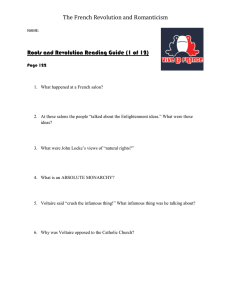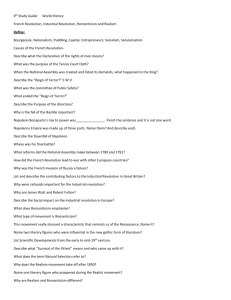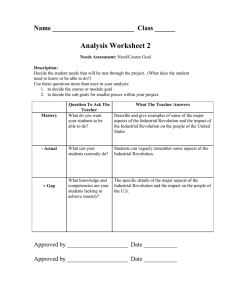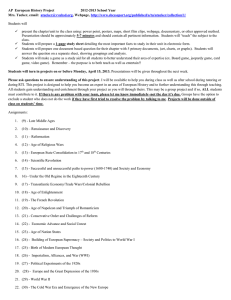+ RVP, Week 10 John Keats
advertisement
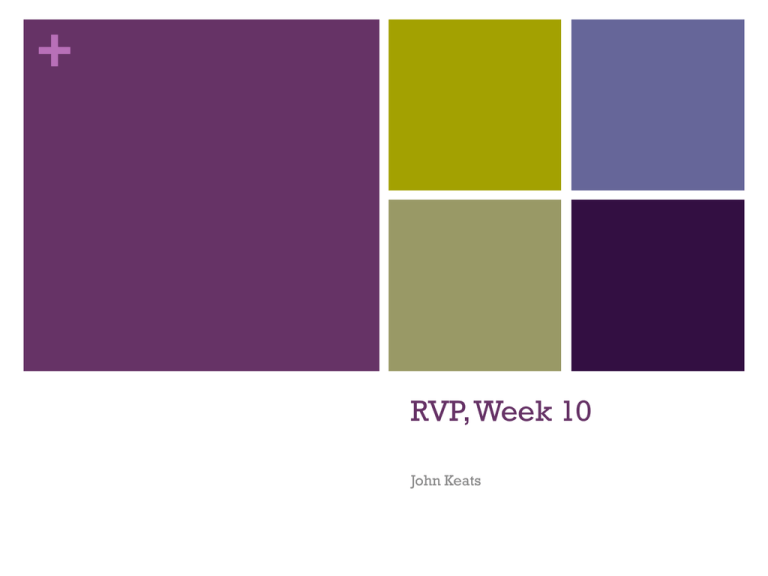
+ RVP, Week 10 John Keats + “The Eve of St. Agnes” (1819) Master-trope: action fixed in cold, formal object (statue, date, and ultimately: poem) Key verb tense: pluperfect (“Whose heart had brooded”)— past action (“brooded”) expressed via a present state (“had”) State changes: solid into ethereal, liquids into other solutions, kinetic action into suspended form + Shorter Keats Poems ‘Ode: to a Nightingale’, ‘Ode on Melancholy’, ‘Ode on a Grecian Urn’ In groups (n/3), survey these poems Tell us what the form of the poem is, using as many formal reading techniques as you can Talk about how form is thematized in the poem This could be the poem reflecting on poetry, or on another art form (as statue in ‘The Eve of St. Agnes’) Bring back to us: one stanza with an unusual stress/meter/sound effect; one moment of polyvalence, with the multiple meanings explained conceptually + Some final context: Romanticism and the French Revolution …The French Revolution exerted a profound influence on European art and thought. Much Romantic poetry expresses the hope associated with the early stages of the revolution, as well as the sense of horror and betrayal aroused by the Reign of Terror. The main political treatises espousing different views on the Revolution are: Burke’s Reflections on the Revolution in France (voices opposition to the Revolution); and Thomas Paine’s Rights of Man and Mary Wollstonecraft’s Vindication of the Rights of Woman (which defend revolutionary tenets). Inspired by the political climate in France, English Romantic poets exalted the worth of the individual, incorporating into their works such themes as universal freedom and equality. When the Committee of Public Safety was established as a war dictatorship, many observers believed that the ideal of popular government had been abandoned and Wordsworth and Coleridge registered disappointment and anger that the goals of the French Revolution had not been fulfilled. http://www2.warwick.ac.uk/fac/arts/english/currentstudents/undergraduate /modules/fulllist/second/en227/context/mason Far spread the moorey ground a level scene Bespread with rush and one eternal green That never felt the rage of blundering plough Though centurys wreathed spring's blossoms on its brow Still meeting plains that stretched them far away In uncheckt shadows of green brown, and grey Unbounded freedom ruled the wandering scene Nor fence of ownership crept in between To hide the prospect of the following eye Its only bondage was the circling sky One mighty flat undwarfed by bush and tree Spread its faint shadow of immensity And lost itself, which seemed to eke its bounds In the blue mist the horizon's edge surrounds Now this sweet vision of my boyish hours Free as spring clouds and wild as summer flowers Is faded all - a hope that blossomed free, And hath been once, no more shall ever be Inclosure came and trampled on the grave Of labour's rights and left the poor a slave + Final context II: Romanticism and Religion I Dissenting Academies Excluded from grammar schools and the two universities, Dissenters developed in their own ‘academies’ an educational system that exploited their want of charter and encouraged vigorous, independent-minded scholarship. Fundamental to the Academies is their independence from the Church, their instituting Principals being some of the most progressive intellects of the period, for example, John Jennings (Kibworth), Phillip Doddridge (Northampton), James Burgh (Stoke Newington) and most importantly, perhaps, Joseph Priestley (Warrington). Academies such as those at Hackney and Hoxton became rather extreme in their Rational Dissent, lending some support to Unitarian ‘heresies.’ In less controversial areas, their syllabuses were at once extensive and comprehensive, including French, Italian, history, political theory, geography, shorthand (compulsory in order to write sermons), a version of English Literature and notably, the new experimental sciences. While Oxbridge remained training colleges for priests, the Academies supported new disciplines and their graduates often proceeded to universities in Scotland or Holland where innovative knowledge could be further developed. http://www2.warwick.ac.uk/fac/arts/english/currentstudents/undergradu ate/modules/fulllist/second/en227/context/mason + Final context II: Romanticism and Religion II Enthusiasm A word that signified religious and political fanaticism, frequently applied to Methodists, radicals and millenarians, but also reworked and secularised by the Romantic poets to mean the sublime inward inspiration necessary for ‘true’ poetry. Enthusiasm was thought to connote an overheating of the brain which caused spiritual insight or madness (and some thought the two were the same). Women and children were thought particularly susceptible to its lure because of their emotional sensibility and undeveloped rationality. Wordsworth and Coleridge, while ambivalent regarding its political and religious associations, embraced its inspirational, imaginative and illuminative capacities. http://www2.warwick.ac.uk/fac/arts/english/currentstudents/undergradu ate/modules/fulllist/second/en227/context/mason + An Angel came to me and said: ‘O pitiable, foolish young man! O horrible! O dreadful state! Consider the hot, burning dungeon thou art preparing for thyself to all Eternity, to which thou art going in such career.’ 132 I said: ‘Perhaps you will be willing to show me my eternal lot, and we will contemplate together upon it, and see whether your lot or mine is most desirable.’ Question for course: how is religious authority portrayed, and what is the individual’s role in it?

